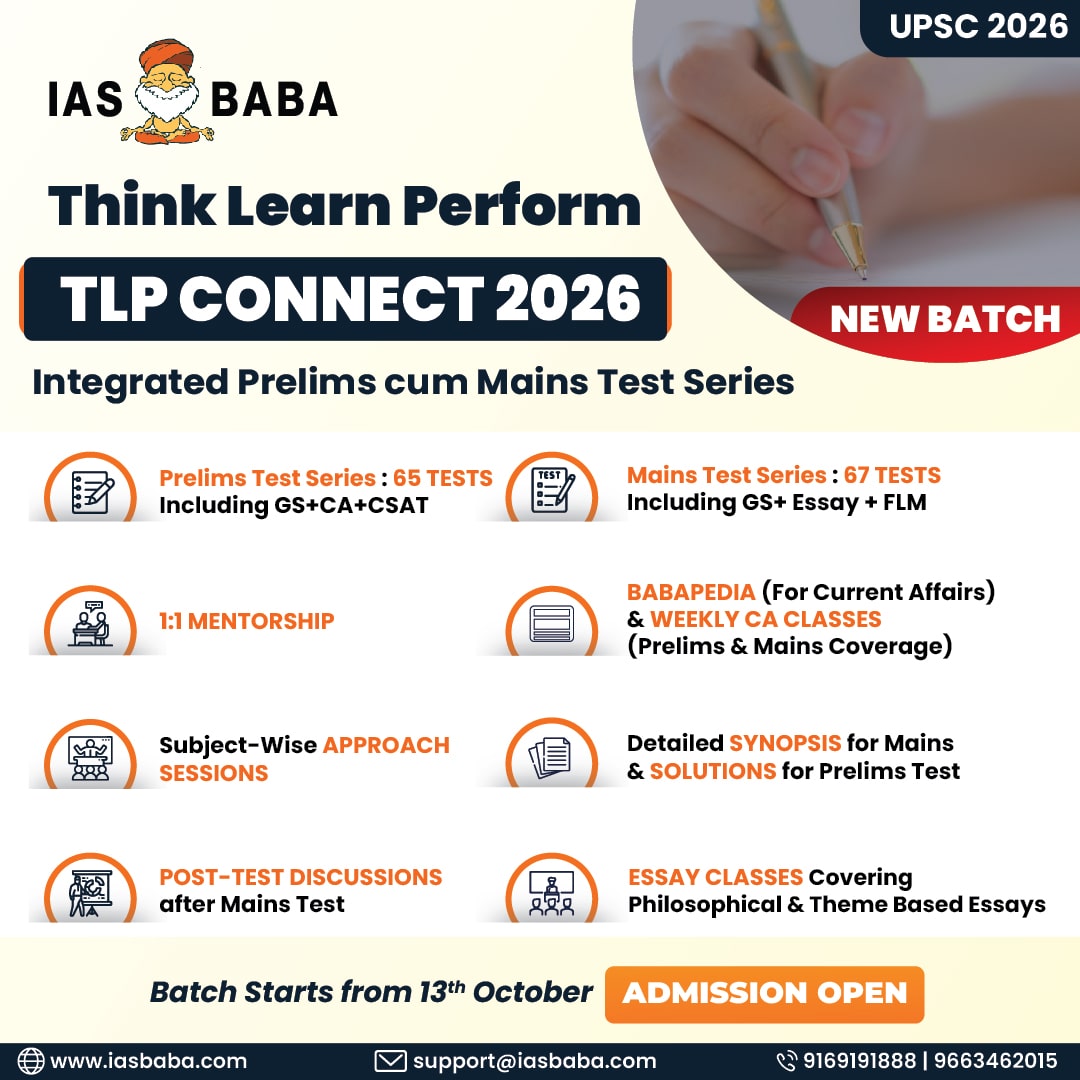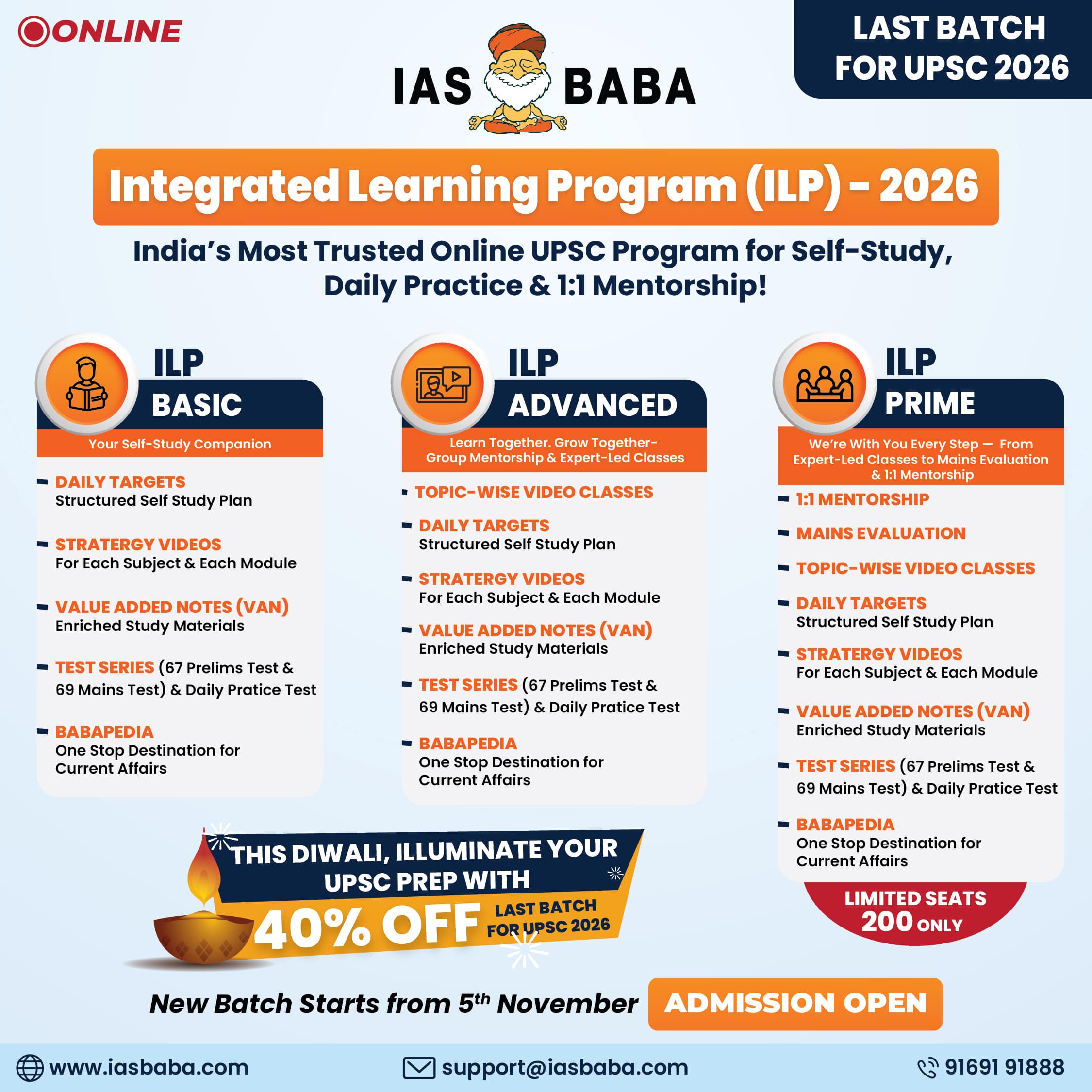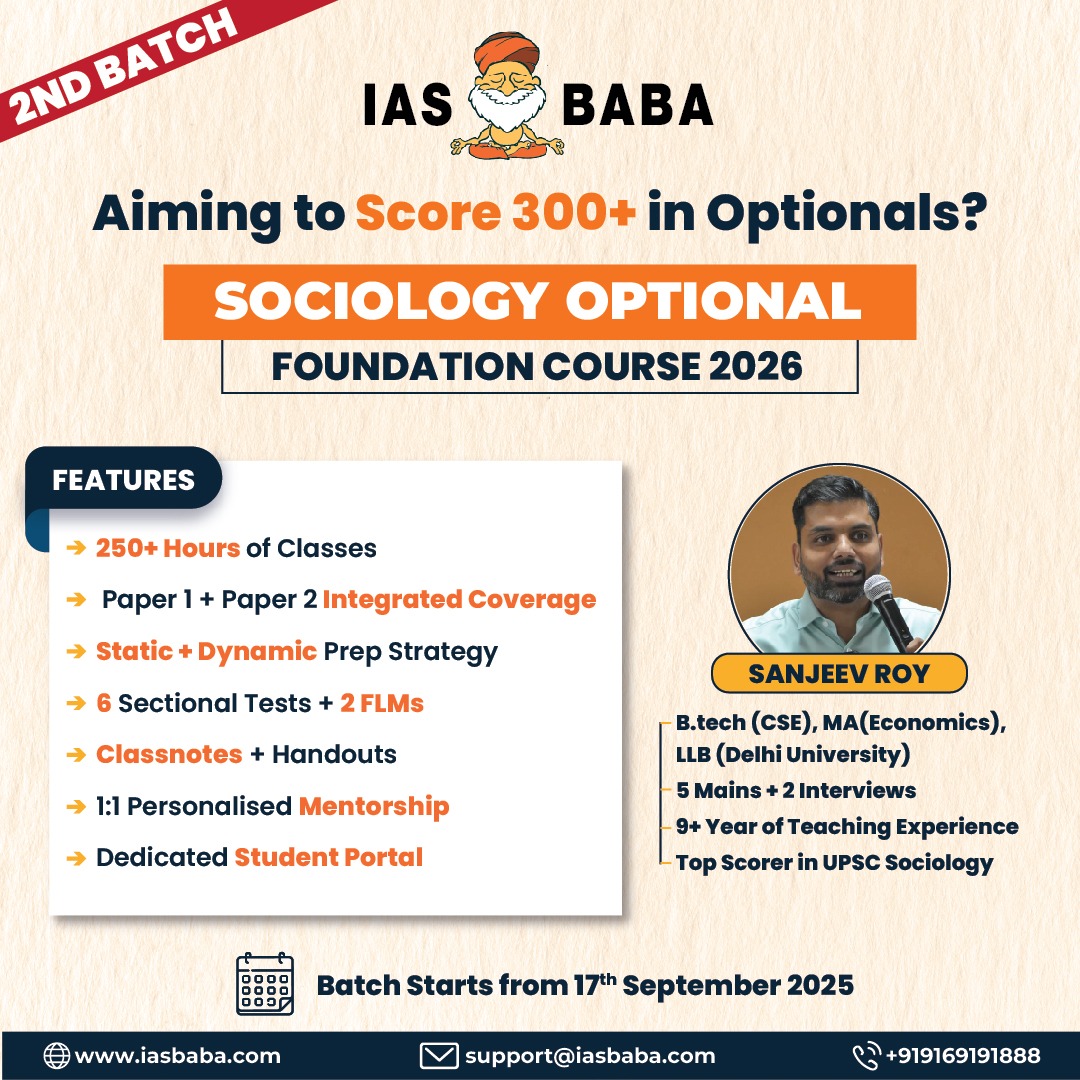IASbaba's Daily Current Affairs Analysis
rchives
(PRELIMS Focus)
Category: POLITY
Context: IIT Madras has topped the NIRF 2025 overall rankings for the seventh consecutive year, also retaining its position as India’s best engineering college for the tenth year.
Key Highlights
- Top Institutions: IIT Madras, IISc Bengaluru, IIT Delhi, IIT Bombay, IIT Kanpur, IIT Kharagpur, IIT Roorkee, AIIMS Delhi, JNU Delhi, Banaras Hindu University.
- Coverage: The tenth edition spanned 17 categories, reflecting the growing scope of Indian higher education.
- Critique: Education Minister Dharmendra Pradhan flagged regional bias in the peer perception metric (10% weight), which favors metropolitan colleges, and called for more inclusive mechanisms from 2026.
Ranking Insights
- Parameters: Teaching, learning, research, graduation outcomes, and inclusivity formed the evaluation core.
- Expansion Plans: Future rankings may add entrepreneurship and data-driven assessments.
- Regional Bias: Peer perception continues to tilt towards metro-based institutions.
Notable Category Leaders
- Universities/Research: IISc Bengaluru.
- Medical: AIIMS Delhi.
- Law: National Law School, Bengaluru.
- Pharmacy: Jamia Hamdard, New Delhi.
- Architecture/Planning: IIT Roorkee.
State Universities & Inclusivity
- Jadavpur University, Kolkata topped state public universities; IGNOU Delhi led among open universities.
- The list included 24 state universities, 22 private deemed universities, and 19 IITs, reflecting sectoral diversity.
Learning Corner:
The National Institutional Ranking Framework (NIRF) is an initiative of the Ministry of Education, launched in 2015, to assess and rank higher education institutions in India. It provides a systematic methodology to promote quality, transparency, and accountability in the education sector.
Key Features:
- Parameters: Teaching and learning, research and professional practice, graduation outcomes, outreach and inclusivity, and perception.
- Coverage: Institutions are ranked under categories such as overall, universities, engineering, management, medical, law, pharmacy, architecture, agriculture, innovation, and others.
- Objective: To guide students, parents, and policymakers with credible benchmarks of performance while encouraging healthy competition among institutions.
- Recent Trends: Growing number of categories, increasing participation of institutions, and policy discussions on refining criteria to reduce regional bias and include entrepreneurship and innovation metrics.
Source: THE HINDU
Category: POLITY
Context : The Ministry of Tribal Affairs has asked Census authorities to enumerate PVTGs separately for the first time to enable accurate data for schemes like PM JANMAN.
Particularly Vulnerable Tribal Groups (PVTGs) are a subcategory of Scheduled Tribes identified by traits such as stagnant/declining population, social isolation, low literacy, and dependence on subsistence activities.
Key Points
- Need for Enumeration: Helps deliver targeted health, education, livelihood, and infrastructure benefits.
- Background: Concept evolved from the Dhebar Commission (1960–61).
- Criteria: Geographical isolation, pre-agricultural practices, poor literacy.
- Status: 75 PVTGs are recognized across 18 states and the Andaman & Nicobar Islands.
- Population: Around 47.5 lakh; Madhya Pradesh has the highest numbers, while groups like Jarawas, Onges, and Sentinelese have fewer than 1,000 members.
Particularly Vulnerable Tribal Groups (PVTGs):
PVTGs are a special category within the Scheduled Tribes, recognized for their extreme vulnerability and backwardness. The concept was introduced following the Dhebar Commission (1960–61) recommendations.
Key Features
- Criteria: Stagnant or declining population, very low literacy, pre-agricultural/ subsistence economy, and social & geographical isolation.
- Status: India identifies 75 PVTGs spread across 18 states and the Andaman & Nicobar Islands.
- Demographics: Total population is about 47.5 lakh, with Madhya Pradesh having the largest share; some groups like the Jarawas, Onges, and Sentinelese have fewer than 1,000 members.
- Policy Support: Covered under targeted schemes such as PM JANMAN, focusing on health, education, livelihoods, and infrastructure.
- Significance: They represent the most marginalized communities, requiring focused interventions beyond general tribal welfare measures.
Source: THE INDIAN EXPRESS
Category: POLITY
Context: The Immigration and Foreigners Bill, 2025 overhauls India’s regime for regulating the entry, stay, and exit of foreign nationals by consolidating four older laws into one.
Key Highlights
- Consolidation: Merges the Passport (Entry into India) Act, 1920; Registration of Foreigners Act, 1939; Foreigners Act, 1946; and Immigration (Carriers’ Liability) Act, 2000.
- Unified System: Introduces a centralized, digital framework for registration, permits, reporting, and data management.
- Authority: Immigration officers get final authority over entry, exit, and admissibility, with national security grounds overriding.
Provisions
- Registration: Mandatory for foreigners at designated posts; district police and regional officers empowered.
- Accommodation Reporting: Hotels and similar establishments must submit records of foreign guests.
- Digital Permits: Required for movement into restricted/prohibited areas.
Exemptions
- Diplomats, official passport holders, Nepal and Bhutan citizens (except via third countries) exempt.
- Refugees: Sri Lankan Tamils (pre-2015) regularized; Tibetans and other registered refugees protected by special orders.
Enforcement
- Digital Infrastructure: Online portals and mobile apps for monitoring.
- Graduated Penalties: Differential fines based on seriousness (e.g., minor overstay penalties).
- Humanitarian Exemptions: Foreign military or events allowed by notification.
Learning Corner:
Fundamental Rights for Foreigners in India
- General Principle:
Fundamental Rights in Part III of the Constitution are available to both citizens and foreigners, except where expressly restricted to citizens only. - Rights Available to Foreigners:
- Article 14: Right to equality before law and equal protection of laws.
- Article 20: Protection in respect of conviction for offences.
- Article 21: Right to life and personal liberty.
- Article 22: Protection in cases of arrest and detention (with certain limits).
- Article 23 & 24: Prohibition of trafficking, forced labour, and child labour.
- Article 25–28: Freedom of religion (subject to public order, morality, health).
- Article 32: Right to constitutional remedies for enforcement of rights.
- Rights Not Available to Foreigners (Citizens Only):
- Article 15 & 16: Prohibition of discrimination and equality of opportunity in public employment.
- Article 19: Six freedoms (speech, movement, residence, profession, etc.).
- Article 29 & 30: Cultural and educational rights of minorities.
- Special Note:
- Enemy aliens may have these rights further restricted during emergencies.
- Foreigners are bound by laws relating to entry, stay, and exit under statutes like the Foreigners Act, 1946 and the new Immigration and Foreigners Bill, 2025.
Source: THE INDIAN EXPRESS
Category: ENVIRONMENT
Context Assam; developed by We Foundation India in collaboration with Gauhati University’s Zoology Department.
- Purpose: Build a nationwide network of conservationists, researchers, and communities for vulture protection and awareness.
- Features: Knowledge hub with scientific updates, population monitoring, campaign materials, and conservation practices.
- Local Focus: Initially disseminated in Assamese to engage grassroots communities, linking vulture survival with livelihoods and public health.
- Conservation Significance: India has nine vulture species, most critically endangered due to diclofenac poisoning and habitat loss.
- Partnerships: Supported by Assam Bird Monitoring Network, LASA Foundation, Suraksha Samitee, and independent conservationists.
Learning Corner:
Vulture Species in India
India hosts 9 species of vultures (of the 23 found worldwide).
- Critically Endangered (IUCN Red List):
- White-rumped Vulture (Gyps bengalensis)
- Indian Vulture (Gyps indicus)
- Slender-billed Vulture (Gyps tenuirostris)
- Red-headed Vulture (Sarcogyps calvus)
- Endangered:
- Egyptian Vulture (Neophron percnopterus)
- Near Threatened:
- Himalayan Griffon (Gyps himalayensis)
- Least Concern (but declining locally):
- Griffon Vulture (Gyps fulvus)
- Cinereous Vulture (Aegypius monachus)
Major Threats
- Diclofenac poisoning (NSAID used in cattle, lethal to vultures).
- Habitat loss and food scarcity.
- Electrocution and collision with power lines.
- Hunting in some regions.
Conservation Measures
- Ban on veterinary diclofenac (2006); promotion of safe alternatives (meloxicam, tolfenamic acid).
- Vulture Safe Zones (around 8 established across India).
- Captive Breeding Centres: Pinjore (Haryana), Rajabhatkhawa (West Bengal), Rani (Assam), Junagadh (Gujarat), etc.
- Action Plan for Vulture Conservation 2020–2025 by MoEFCC.
- First Vulture Conservation Portal (2025) launched in Assam to network researchers and communities.
Source: THE INDIAN EXPRESS
Category: ENVIRONMENT
Context: NITI Aayog Workshop on Coal Gasification
- Objective: Workshop in New Delhi on “Coal Gasification Technology for Indian High Ash Content Coal” aimed at advancing the National Coal Gasification Mission, Make in India, and Atmanirbhar Bharat.
- Focus: Addressing challenges of gasifying Indian coal with 25–45% ash content; experts highlighted circulating fluidized bed gasification as most suitable.
- Policy Support: Ministry of Coal announced ₹8,500 crore Viability Gap Funding for public and private projects, with Letters of Award for selected firms.
- Indigenous Technology: IIT Delhi, BHEL, CIMFR, and others showcased successful pilot projects proving feasibility of gasification using domestic tech.
- Strategic Significance: Coal gasification positioned as vital for energy security, cleaner coal utilization, and reducing import dependence; next steps include CCUS integration and scaling pilot projects for commercial deployment.
Learning Corner:
Coal Gasification
- Definition: Coal gasification is a process that converts coal into synthesis gas (syngas), a mixture of carbon monoxide (CO), hydrogen (H₂), carbon dioxide (CO₂), and methane (CH₄).
- Process: Coal reacts with controlled amounts of oxygen, steam, or air at high temperature and pressure, without complete combustion.
- Uses of Syngas:
- Power generation (Integrated Gasification Combined Cycle – IGCC)
- Production of methanol, ammonia, urea, and synthetic natural gas (SNG)
- Hydrogen production and as feedstock for petrochemicals
- Advantages:
- Cleaner utilization of coal with reduced SOx, NOx, and particulate emissions compared to direct burning
- Enables Carbon Capture, Utilization, and Storage (CCUS)
- Reduces dependence on imported oil and natural gas
- Challenges in India:
- High ash content in Indian coal (25–45%) makes gasification technologically demanding
- High costs of setup and operation
- Need for robust infrastructure and indigenous R&D
- Policy Context:
- India aims for 100 MT of coal gasification by 2030
- National Coal Gasification Mission supports projects through viability gap funding and public-private partnerships
Source: PIB
(MAINS Focus)
Introduction (Context)
Indian Railways has recently tested its first hydrogen-powered coach, marking a significant step towards the deployment of Hydrogen Fuel Cell (HFC) technology in India’s vast railway network.
Hydrogen-powered trains, or hydrail, are emerging as a promising zero-emission alternative to diesel-electric locomotives.
What are Hydrogen Trains?
- Hydrogen trains are electric trains with an onboard power source, unlike conventional electric trains that are powered via overhead wires.
- They use HFC (Hydrogen Fuel Cell) technology, which generates energy through the electrochemical reaction of compressed hydrogen with atmospheric oxygen, emitting water vapour as the sole byproduct making it a zero-emission mechanism.
- The electricity produced by the fuel cell is stored in batteries, which provide additional power during acceleration and climbing inclines.
- Hydrogen trains also employ regenerative braking technology, which captures the kinetic energy (motion energy) generated during braking and converts it into electricity to recharge onboard batteries.
Hydrogen Fuel Cell vs Electric Trains
- Hydrogen trains work by first using electricity to produce hydrogen (through electrolysis), and then converting that hydrogen back into electricity inside the train to run it. Because of this double conversion process, some energy is lost along the way.
- Electric trains, on the other hand, draw electricity directly from overhead wires. This makes them more energy-efficient, especially when the power comes from renewable sources like solar or wind.
- This means that, over their full life cycle, electric trains are generally more efficient than hydrogen trains.
Green Hydrogen vs Grey Hydrogen
- Green Hydrogen: Made using renewable energy (like solar or wind) to split water into hydrogen and oxygen. This process does not release harmful gases, so the trains powered by it can truly be called zero-emission.
- Grey Hydrogen: Produced from fossil fuels (like coal or natural gas). This process releases carbon dioxide (CO₂), which reduces the environmental benefits of hydrogen trains.
- For hydrogen trains to actually fight climate change, India needs to shift from grey hydrogen to green hydrogen at a large scale. Only then can hydrail become a genuinely clean and climate-friendly option.
Advantages of Hydrail
- Eliminates smoke emissions from fuel combustion, reducing noise and air pollution.
- Operates on both electrified and non-electrified routes, ensuring greater flexibility.
- Particularly useful for routes where overhead electrification is unfeasible or prone to disruption.
- Can be refuelled in 20–25 minutes, faster than battery-electric train recharging.
- Supports India’s net-zero target by 2070; Indian Railways already reduced fuel use by 136 crore litres (2018–19 to 2023–24).
- Though initial investments are high, cost-effective on non-electrified routes by avoiding overhead electrification costs.
- Reduces dependence on imported diesel, strengthening energy security and improving balance of payments.
Challenges
- Hydrail has a substantially high initial cost of production compared to both electric and diesel trains.
- It requires the development of an extensive system for hydrogen production, storage and distribution – an infrastructure that is largely absent in India today.
- The massive refueling stations and machinery needed to support the substantial fleet of hydrogen trains present another logistical and financial challenge.
- The highly flammable nature of hydrogen requires adherence to strict safety standards from production to storage and refuelling, necessitating further investment in safety infrastructure and training for railway personnel.
- Currently, most hydrogen in India is derived from fossil fuels → undermines decarbonisation goals.
Way forward
- Leverage India’s growing renewable energy capacity to scale up green hydrogen production and reduce costs.
- Develop a decentralised hydrogen infrastructure focusing on storage and refuelling, inspired by the Hydrogen Highways model under NGHM.
- Invest heavily in research and development to improve hydrogen fuel cell efficiency, safety standards, and cost competitiveness.
- Ensure long-term policy support with clear roadmaps, incentives, and public–private partnerships to sustain momentum.
- Strategically deploy hydrogen trains on non-electrified, remote, and hilly routes where they have maximum advantage.
Conclusion
Hydrogen trains mark a significant milestone in India’s pursuit of a sustainable and decarbonised transport system. With the right mix of renewable energy integration, infrastructure development, and supportive policies, India can position itself as a global leader in green hydrogen innovation.
Mains Practice Question
Q Hydrogen trains represent both an opportunity and a challenge for India’s transition towards sustainable transportation.” Discuss. (250 words, 15 marks)
Source: UPSC Environment Current Affairs 2025: Hydrogen trains for a truly green and sustainable form of transportation
Introduction (Context)
The judiciary is often seen as the guardian of constitutional morality, demanding accountability and transparency from the legislature and executive. However, recent revelations about Justice B.V. Nagarathna’s dissent in the Collegium’s recommendation to elevate Justice Vipul M. Pancholi highlight the opaque nature of judicial appointments. This raises serious concerns about transparency, accountability, and democratic legitimacy within the judiciary itself.
Constitutional Provisions Related to the Appointment of Judges
- Article 124(2) – Supreme Court Judges
- Judges are appointed by the President through a warrant.
- Appointment requires consultation with Chief Justice of India (mandatory for all judges except CJI) and other SC and High Court judges (discretionary for the President)
- Article 217(1) – High Court Judges
- Judges appointed by the President after consultation with: Chief Justice of India, Governor of the State and Chief Justice of the High Court (mandatory for all except Chief Justice)
- Tenure: up to 62 years (except additional/acting judges under Article 224).
- Here, consultation is mandatory, unlike Article 124(2) which allows some discretion.
About Collegium system
- The Collegium System is the way judges of the Supreme Court and High Courts are appointed in India.
- It is not written in the Constitution or in any law. Instead, it was created by the Supreme Court itself through judgments.
- In this system, a group (called the Collegium) of the 5 senior-most judges of the Supreme Court, including the Chief Justice of India (CJI), decide:
- Who will be appointed as a judge in the SC and High Courts.
- Who will be promoted (from High Court to SC).
- Transfers of judges from one High Court to another.
It aims to keep the judiciary independent from political influence.
Key Supreme Court Judgments on Judicial Appointments
- First Judges Case (S.P. Gupta v. Union of India, 1981) – Introduced the idea of consultation between the President and CJI for appointments, but gave more power to the executive.
- Second Judges Case (Supreme Court Advocates-on-Record Association v. Union of India, 1993) – Held that the Chief Justice of India and senior judges have primacy in appointments, reducing executive control.
- Third Judges Case (1998) – Clarified the Collegium system, giving a five-member panel of senior SC judges, headed by the CJI, the authority to select and recommend judges for the Supreme Court and High Courts.
Issues with the collegium system
- The Collegium operates in closed-door meetings without publicly disclosing deliberations. Even dissent by senior judges (e.g., Justice B.V. Nagarathna’s objection) is hidden from the public.
- Judicial appointments are made by a self-selecting group of judges with no role for the legislature or public scrutiny. This creates a “judges appointing judges” model, which lacks democratic accountability.
- Collegium decisions are rarely explained; reasoning behind appointments, rejections, or transfers remains unknown.
- As there is no transparency, appointment on the basis of preferences are also patronized, over deserving candidates and qualifications.
- Separation of judiciary is the keystone of Indian democracy, and this idea has been emphasized by the constitution makers by including the Article 50 (directive principles of state policy) mentioning that the State shall take steps to separate the judiciary from the executive in the public services of the State. But the opaque collegium system is used by the politicians to fulfill their self-interest.
For a short period in 2018, the Court uploaded fuller reasons for the Collegium’s choices and rejections. However, the experiment was short lived, with the explanation that disclosure might damage reputations.
Importance of transparency in appointments
-
- Transparency in judicial appointments helps build trust and legitimacy in the system.
- Countries like Britain and South Africa show that making criteria and assessments public improves accountability.
- Judges make decisions on civil liberties, executive power, and federal authority, so citizens have a right to know why judges are appointed.
- Publicly sharing reasoning ensures the judiciary follows the same accountability it expects from other branches of government.
- Even though judges are unelected, they are entrusted with protecting rights against majoritarian excesses and maintaining constitutional balance. Transparency does not weaken their independence; instead, it reinforces trust and strengthens democracy.
Way Forward
- The Collegium must embrace reform to ensure judicial appointments are transparent and accountable.
- The process should meet the highest standards of justification, moving away from a culture of secrecy.
- Opportunities for change should be actively implemented and sustained, rather than rolled back, to strengthen transparency and integrity.
- Structured reforms could include public disclosure of dissenting opinions, clear reasoning for appointments, and mechanisms to maintain independence while enhancing openness.
Conclusion
A judiciary that follows the same standards of openness and accountability it expects from other branches will not lose autonomy. On the contrary, transparency will strengthen public trust, reinforce legitimacy, and anchor the judiciary’s independence firmly in democratic values.
Reforming the Collegium is essential to preserve both judicial authority and the credibility of India’s democracy.
Mains Practice Question
Q Discuss the need for transparency in the Collegium system of judicial appointments in India and its impact on judicial legitimacy. (250 words, 15 marks)














